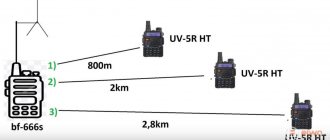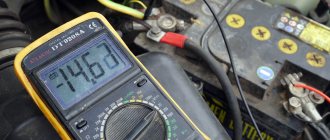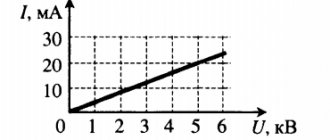Pulsating current, the shape of the pulses is close to sawtooth Direct current Arbitrarily varying current Alternating sinusoidal current Electrodynamics.
DC [52:07] DC
- electric current, the direction of flow of which does not change over time.
Otherwise, direct (constant, unchanging) current is a flow of electric charges directed in one direction. Direct current can flow through a conductor, such as a wire, but can also flow through semiconductors, insulators, or even through a vacuum, as in electron or ion beams (thermionic current). This electric current flows in a constant direction, which distinguishes it from alternating current. A battery is a prime example of a constant current source. The term previously used for this type of current is galvanic current.
The abbreviations AC and DC are often used to refer to alternating and direct current or voltage, respectively.
[edit] History
Direct current was obtained in 1800 using a battery by the Italian physicist Alessandro Volta. The nature of the current flow was not yet clear. French physicist André-Marie Ampère proposed that current flows in one direction from the positive to the negative electrode. When French instrument maker Hippolyte Pixie built the first dynamo-electric generator in 1832, he discovered that when the magnet used passed loops of wire every half turn, it caused electricity to flow back, generating alternating current. At Ampere's suggestion, Pixie later added a "switch" type commutator, in which contacts on the shaft act with "brush" contacts to produce direct current.
In the late 1870s and early 1880s, power plants began to produce electricity. They were first configured to power light sources from an electric arc (a common form of street lighting) that operated at very high voltage (usually over 3000 volts) of direct or alternating current. Low-voltage direct current subsequently became widespread for indoor lighting in businesses and homes after inventor Thomas Edison launched his incandescent electric "utility" (lamp) in 1882. Due to the significant advantages of alternating current over direct current through the use of transformers to step up and step down voltage to allow much longer transmission distances, direct current for power supply was replaced over the next few decades by alternating current.
The high voltage DC transmission system was developed in the mid-1950s and is now (in the 2020s) an alternative to long distance high voltage AC transmission systems. For long submarine cables (e.g. between countries, eg NorNed) this DC option is the only technically feasible option. For applications requiring direct current, such as a catenary rail power system, alternating current is supplied to substations where rectifiers are used to convert the power to direct current.
Types of electric current sources
There are the following types of electric current sources:
- mechanical;
- thermal;
- light;
- chemical.
Mechanical sources
In these sources, mechanical energy is converted into electrical energy. The transformation is carried out in special devices - generators. The main generators are turbogenerators, where an electric machine is driven by a gas or steam flow, and hydrogenerators, which convert the energy of falling water into electricity. Most of the electricity on Earth is produced by mechanical converters.
Heat sources
Here thermal energy is converted into electricity. The occurrence of electric current is caused by the temperature difference between two pairs of contacting metals or semiconductors - thermocouples. In this case, charged particles are transferred from the heated area to the cold one. The magnitude of the current depends directly on the temperature difference: the greater this difference, the greater the electric current. Semiconductor-based thermocouples produce thermopower 1000 times greater than bimetallic ones, so current sources can be made from them. Metal thermocouples are used only for measuring temperature.
Currently, new elements have been developed based on the conversion of heat released during the natural decay of radioactive isotopes. Such elements are called radioisotope thermoelectric generator. A generator using the plutonium-238 isotope has proven itself well in spacecraft. It produces a power of 470 W at a voltage of 30 V. Since the half-life of this isotope is 87.7 years, the service life of the generator is very long. A bimetallic thermocouple converts heat into electricity.
Light sources
With the development of semiconductor physics at the end of the twentieth century, new current sources appeared - solar batteries, in which light energy is converted into electrical energy. They use the property of semiconductors to produce voltage when exposed to light. This effect is especially strong in silicon semiconductors. But still, the efficiency of such elements does not exceed 15%. Solar batteries have become indispensable in the space industry and have begun to be used in everyday life. The price of such power supplies is constantly decreasing, but remains quite high: about 100 rubles per 1 watt of power.
Chemical sources
All chemical sources can be divided into 3 groups:
- Galvanic
- Batteries
- Thermal
Galvanic cells work based on the interaction of two different metals placed in an electrolyte. The pairs of metals and electrolyte can be different chemical elements and their compounds. The type and characteristics of the element depend on this.
IMPORTANT! Galvanic cells are used only once, i.e. Once discharged, they cannot be restored.
There are 3 types of galvanic sources (or batteries):
- Salt;
- Alkaline;
- Lithium.
Salt, or otherwise “dry” batteries use a paste-like electrolyte made from a salt of some metal, placed in a zinc cup. The cathode is a graphite-manganese rod located in the center of the cup. Cheap materials and ease of manufacturing of such batteries made them the cheapest of all. But their characteristics are significantly inferior to alkaline and lithium ones.
[edit] Miscellaneous designations
Varieties of direct current (from top to bottom): current from the battery, current from the half-wave rectifier, current from the full-wave rectifier.
The term direct current is used to designate power systems that employ only one polarity of voltage or current, and to designate a constant, zero frequency, or slowly varying local average voltage or current signal. For example, the voltage in a DC source is constant, as is the current through the DC source. It can be shown that any constant voltage or current wave can be decomposed into the sum of a direct current component and a zero-average, time-varying component; The DC component is defined as the expected value, or average, of the voltage or current over time.
Although DC means "constant current", DC often refers to "constant polarity".
Output current
To be honest, everything that was said above is, to put it mildly, a secondary selection criterion. Because the main parameter of DC power supplies is the output current, that is, the rated load current.
Attention! Remember once and for all, the rated load current must be transferred from the network to the load always and constantly, regardless of the operating circumstances of the device. It should operate throughout the entire consumption period without distortion, decreases or increases. Regardless of what the voltage is in the network or from the battery, what the external temperature is, whether there are differences or not.
All other parameters are additional or auxiliary. Some manufacturers indicate a huge number of values and characteristics. Don't be fooled by them, they'll just cloud your head.
- And if the rated load current is not indicated either in the passport or on the unit body, it means that you have a useless piece of metal in front of you.
- If you find this inscription: “rated load current without battery,” then know that through the network it can be rated, but through the battery it can be underestimated.
[edit] Schemes
A DC circuit is an electrical circuit consisting of any combination of constant voltage sources, constant current sources, and resistors. In this case, the voltages and currents of the circuit do not depend on time. The specific voltage or current in a circuit does not depend on the past value of the voltage or current in it. This means that the system of equations representing a DC circuit does not involve integrals or derivatives with respect to time.
If a capacitor or inductor is added to a DC circuit, the resulting circuit is not, strictly speaking, a DC circuit. However, in most of these circuits, there is a constant current solution. This solution gives the voltages and currents of the circuit when the circuit is in a steady state of constant current. Such a scheme is represented by a system of differential equations. The solution to these equations usually contains a time-varying, or transition, part, and a constant, or constant, part. It is this part of the steady state that is the constant current solution. There are some circuits that do not have a DC solution. Two simple examples are a constant current source connected to a capacitor, and a constant voltage source connected to an inductor.
In electronics, a circuit powered by a direct current source, such as a battery, is commonly called a direct current circuit, even if it is meant to simply operate on direct current.
Characteristics of available power supplies
When designing electrical installations in accordance with the IEC 60364 set of standards, it is necessary to know the characteristics of power supplies. In order to design a safe electrical installation that meets the requirements of the IEC 60364 set of standards, it is necessary to obtain relevant information from the electrical distribution network operator. Characteristics of power supplies must be included in the design and operational documentation of electrical installations. If the electrical network operator changes the characteristics of power supplies, this may affect the safety of the electrical installation.
Here are these characteristics (according to GOST 30331.1-2013):
- Type of electric current: alternating and (or) constant.
- Types of conductors used in electrical circuits of electrical installations:
— alternating current: phase (linear) conductor, neutral conductor, protective conductor;
— direct current: pole (linear) conductor, middle conductor, protective conductor.
Note - In one conductor, for example, in a PEN, PEM or PEL conductor, the functions performed by several conductors can be combined.
- Valid values:
— voltage and permissible voltage deviations;
— voltage losses, voltage fluctuations and voltage drops;
— frequency and permissible frequency deviations;
— maximum permissible current;
— total resistance of the ground fault loop before entry into the electrical installation;
— expected short circuit currents.
Standard values for voltage and frequency are given in IEC 60038.
Protective precautions inherent to the power supply include, for example, grounding the neutral in an AC electrical system or grounding the live mid-section in a DC electrical system.
However, following characteristics of any power source used and the normal range of these characteristics, if necessary, must be determined by calculation, measurement, collection of material or inspection :
- rated voltage(s);
- type of current and its frequency;
- expected short circuit current at the input of the electrical installation;
- the impedance of the ground fault loop of that part of the electrical system that is located outside the electrical installation;
- compliance with the requirements of the electrical installation, including ensuring maximum load;
- type and rated characteristics of the overcurrent protection device installed at the input of the electrical installation.
These characteristics should be evaluated for both external and internal power supplies. The requirements apply to main power supplies, safety system power supplies, and backup power supplies.
[edit] DC sources
A simple source of direct current is a chemical source (voltaic cell or battery), since the polarity of such a source cannot spontaneously change. To produce direct current, electric machines also use direct current generators. In electronic equipment powered by alternating current, a rectifier is used to produce pulsed direct current. Next, to reduce ripple, a smoothing filter and, if necessary, a voltage stabilizer can be used.
Pulse sources
Circuits using input network voltage transformers are called linear. In switching power supplies, double conversion is performed - first, the alternating voltage is converted into direct voltage by the rectifier, then an alternating pulse voltage of a higher frequency is generated, which is again converted into a direct voltage of the required value in the output stage.
Pulse generators produce a continuous pulse sequence with a frequency of (15-60) kHz. The output voltage is regulated by pulse width modulation (PWM), in which the signal level at the output of the power supply is determined by the width of the pulses generated by the generator and their duty cycle value. Regulated pulse-type DC power supplies are increasingly used in the creation of equipment for various purposes.
[edit] Application
Direct current has many uses, from recharging batteries to large power supplies for electronic systems, electric motors and the like.
Direct current is widely used in technology: powering the vast majority of electronic circuits, in cars, trolleybuses, electric locomotives, in some types of cranes, in battery-powered handheld portable tools, etc.
Low voltage direct current is used in electrometallurgy for the melting and electrolysis of ores, primarily aluminum.
High-voltage direct current is used to transmit large amounts of electricity from distant generation facilities or to interconnect AC electrical networks.
Operating principle
Each marking of current sources determines the principle of its operation. In a standard situation, energy is generated through the interaction of component parts, namely:
- Mechanical type. As a result of the interaction of mechanism parts, friction occurs. Due to this phenomenon, static electricity arises and is converted into current.
- Mechanical structures work by producing sequentially moving charged particles. The phenomenon occurs due to the interaction of a chemical element with an electrolyte. Charged particles leave the structure of the metal crystal lattice, becoming part of the conducting liquid.
- Solar batteries (light sources) work by knocking out charged particles from a dielectric (silicon) base under the influence of a light flux. This creates constant tension.
- Thermal. As a rule, these are 2 metal bases connected in series. One part heats up, while the other remains cooled. When the temperature regime changes, a temperature difference occurs, resulting in the movement of charged particles.
You may be interested in this: Why is potential equalization needed?
Important! Any change in the structure of a substance can lead to irreversible consequences that will manifest themselves during the operation of the device.
Current source operation
By moving electric charges along a section of a circuit, electric current does work. It consists of the work of Coulomb forces and the work of external forces:
A = Shark + Astor.
The work of a source is the work of external forces to transfer electrical charges along a conductor over time:
Stork = Astor = ε * I * t,
Where:
- ε – emf (V);
- I – current (A);
- t – time (s).
The work of electric current determines the degree of conversion of electricity into its other forms.
Converting AC to DC
For such a transformation, the optimal method is to use rectifiers:
- Connecting the diode bridge is the first step in this procedure. The design of 4 diodes with the required power contributes to the process of cutting off the upper boundaries of the already familiar alternating sinusoids. In this way, a unidirectional current is achieved.
Changes resulting from decreased ripple are shown in blue.
- are installed to reduce the operating level of pulsation if necessary.
Chemical sources
The production of positive and negatively charged particles in chemical direct current sources is carried out through chemical reactions. According to the classification of chemical sources, they are divided into 3 groups:
- galvanic cells, which are primary sources;
- electric rechargeable batteries (AB), or secondary HIT;
*HIT - chemical current sources.
Galvanic cells use a principle of operation based on the interaction of two metals through an electrolyte medium. The type and characteristics of the CIT depend on the selected pair of metals and the composition of the electrolyte. Two metal electrodes of the current source, by analogy with a device of one-way conductivity, are called anode (“+”) and cathode (“-“).
The materials for making the anode can be lead, zinc, cadmium and others. The cathode is made of lead oxide, graphite, manganese oxide, and nickel hydroxide. Based on the composition of the electrolyte, galvanic cells are divided into 3 types:
- salt or “dry”;
- alkaline;
- lithium
In the first two types of elements, a graphite-manganese rod (cathode) is placed along the axis of a zinc cylindrical cup (anode). The free space between them is filled with a paste based on ammonium chloride (saline) or potassium hydroxide (alkaline).
In lithium cells, the zinc anode is replaced with alkaline lithium, which has led to a significant increase in operating time. The cathode material in them determines the output voltage of the battery (1.5-3.7) V. Primary CITs are single-acting sources. Its reagents, which are consumed during operation, cannot be restored.
Batteries are devices in which the electrical energy of an external current source is converted into chemical energy during charging and its accumulation. During operation (discharge), a reverse transformation occurs - chemical energy serves as a source of direct electric current.
The main types of batteries include:
- lead-acid;
- nickel-cadmium alkaline;
- lithium-ion.
To create chemical processes, a set of plates is placed in an electrolyte solution. In batteries created using modern technologies, the solution is not a liquid, but a gel composition (GEL) or honeycomb separators impregnated with electrolyte and placed between lead plates (AGM).
Lead-acid and nickel-cadmium alkaline batteries for operation as DC sources for starting automobile engines are assembled from a set of individual battery cells (“cans”). Each “can” provides a voltage of 2.1 V at its terminals. 6 elements connected in series and placed in a shock-resistant housing have the 12 V necessary for starting the engine at the battery output terminals.
In lithium-ion batteries, lithium ions serve as electric current carriers. They are formed on a cathode made of lithium salt. The anode can be made of graphite or cobalt oxides. The DC voltage at the battery output can vary between (3.0-4.2) V depending on the materials used. These batteries have a low self-discharge current and allow a large number of charge/discharge cycles. Thanks to this, all modern gadgets use batteries of this type.
Ideal current source
If the current passing through a two-terminal network and removed from its contacts does not change depending on the voltage across these contacts, then this is an ideal current source. Ohm's law, which states that the current strength in a section of a circuit is directly proportional to voltage and inversely proportional to resistance, refers to such a standard. Formula:
I = U/R, where:
- I – current, A;
- U – voltage, V;
- R – resistance, Ohm.
In this case, it is assumed that the internal resistance of the source is close to or equal to infinity. This means that the external parameters of the circuit, which change the voltage at the output of the two-terminal network, do not change the current.
Attention! The power at the source terminals will increase with increasing load resistance; at a constant current, this gives an increase in power P = U*I. In this case, we can talk about an ideal power source.
Any type of source is far from an ideal generator. A properly selected and undamaged power source will last a long time. The main thing is that operation takes place in the recommended mode. Since most products are associated with chemical processes, the storage and disposal of these products are carried out in accordance with environmental standards and regulations.









